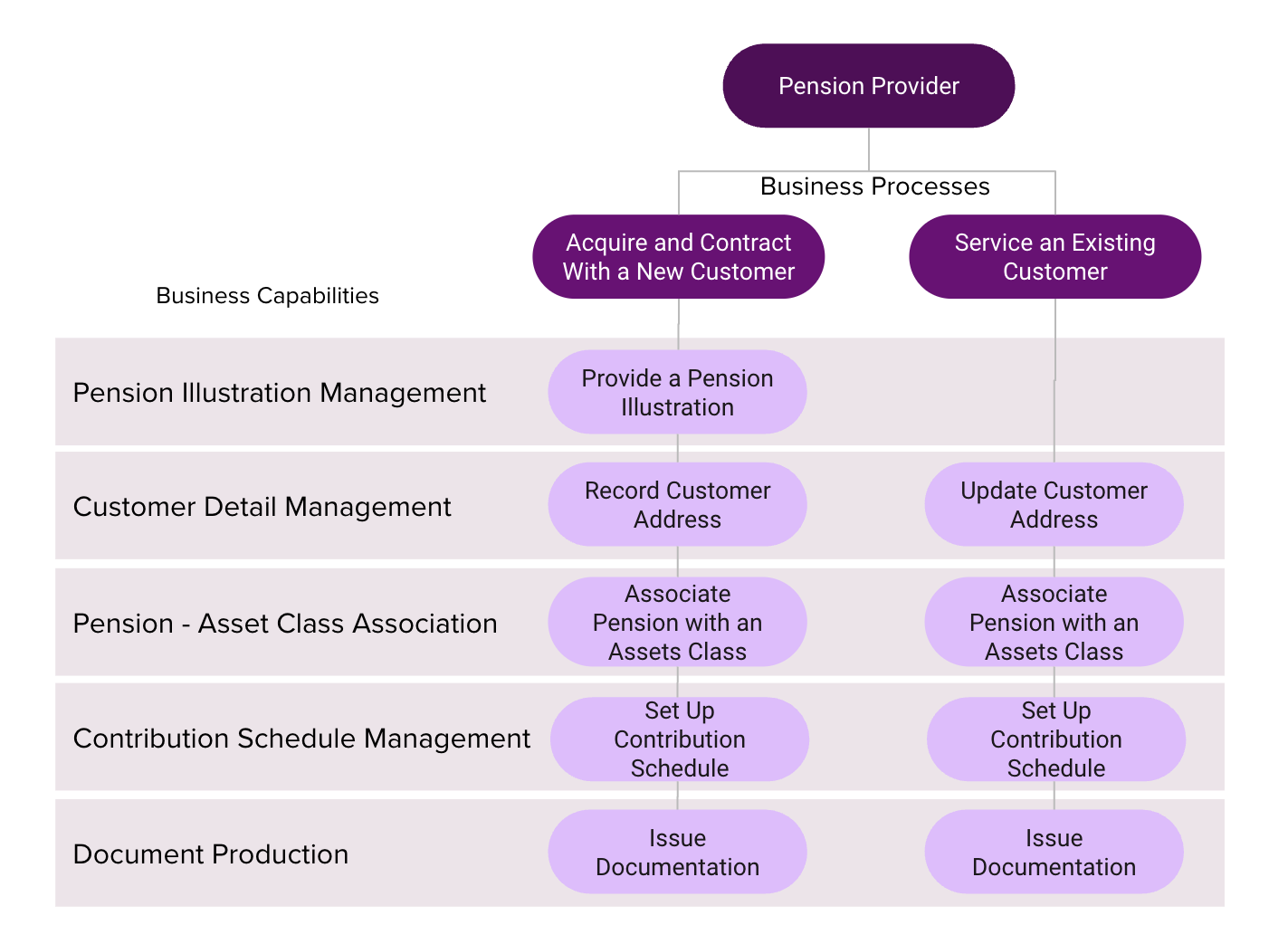Since its inception decades ago, IT has transformed from a traditional support function into a pivotal operational element, serving as a cornerstone for many enterprises.
Today, the average large business leverages IT to do so much. Collecting and analyzing data, streamlining and automating processes, reducing costs, accelerating onboarding, among many other critical functions and processes that enable the modern organization to function successfully.
With IT's immense importance, comes a pressing need to ensure it is efficient and effective. To fully exploit the technological resources available to them, organizations must formulate strategies while maintaining alignment of IT with business objectives. One important aspect of achieving this successfully lies in understanding and defining business’ capabilities.
By mapping out an organization's business capabilities, vital insights into the current state and future direction of the company are gained, facilitating informed decision-making and strategic planning. This article will explore exactly what a business capability is.
Jump to:
- What Is A Business Capability?
- What is the Difference Between Business Capabilities and Business Processes?
- How to Identify and Name Business Capabilities: Guidelines
- Types of Business Capabilities
- The Importance of Documenting Business Capabilities
- What Are the Benefits of Business Capabilities and Analyzing Them?
- Business Capability Modeling: Kickstart the Process with Ardoq
- Key Takeaways on Business Capabilities
What Is A Business Capability?
By definition, business capability is an activity or ability that enables an organization to achieve specific goals or objectives.
Enterprise Architecture and business capability are related concepts in organizational management and strategy, but they serve different purposes.
- Enterprise Architecture (EA) is a holistic approach to designing, analyzing, and managing an organization's structures, processes, information, and technology. It provides a blueprint for aligning business processes and goals with IT infrastructure and applications.
- Business capability refers to the specific abilities and capacities an organization has to carry out its business functions and achieve its strategic objectives. It represents what the organization can do or is good at doing.
To cut through all the jargon, modelling business capabilities is a way to get an understand what a company does and can do. It’s a helpful method of pinpointing gaps and redundancies within an organization, identifying pain points, and prioritizing where to focus resources.
By defining its business capabilities, an organization can identify where it is and where it needs to be, ensuring it is prepared for current trends and future changes.
For more information on organizational capability, 9 Business Capability Examples: Modeling an Organization Successfully provides more detailed examples of defining business capabilities.
See how one of the world's largest media organizations became agile by using Ardoq to map their capabilities and more.
What is the Difference Between Business Capabilities and Business Processes?
Business capabilities can be further broken down into more specific sub-capabilities. It is important to note that capabilities may sound like organizational structures and specific teams. Still, they are decoupled from the “who” and “how,” focusing only on describing “what” an organization can do.
The organization’s technology is part of the “how,” and organizational structure informs part of the “who.” It is also important not to confuse business capabilities with business processes, although they can deal with the same type of information. Business processes are logical sequences of activities for a specific outcome, while business capabilities are logical groups of activities around a common resource or information type.
Business processes are logical sequences of activities that deliver a defined outcome, typically in response to a common event. While business capabilities are logical groups of activities. These activities are usually grouped by a common resource that they access, such as a particular type of information.
 As you can see in the example above, different business processes carry out the same activities and hit the same information at different times. So, building a business capability model around processes and not information would lead to many duplicated activities. This makes it a poor foundation for analyzing business and IT efficiency.
As you can see in the example above, different business processes carry out the same activities and hit the same information at different times. So, building a business capability model around processes and not information would lead to many duplicated activities. This makes it a poor foundation for analyzing business and IT efficiency.
However, business capabilities are de-duplicated, serving as an efficiency benchmark for an organization’s business processes and IT systems. They are also modular, so they can be recombined to build new operating models, products, and services.
It’s this componentized nature of business capabilities that makes them so powerful.
Examples of Business Capabilities
- General Accounting
- Corporate Communications
- Recruitment and Hiring
- Financial Management
- Product Development
Get more detailed insight into business capability examples and how to assess their effectiveness.
How to Identify and Name Business Capabilities: Guidelines
To tackle the question of "What are business capabilities in my organization?", we must first answer: “What tasks are needed to keep this business going?”
For example, a company needs to know how much it will earn at the end of the month after tax. The capability for this is identified as “Monthly Net Revenue Management.” Note that the capability describes the what, not the how (e.g., which digital tools or systems to use) or the who (e.g., which team or department would be responsible for it). These details will come in later in the process of business capability modeling.
It’s important to remember that while tools may change over time, a company’s objectives will almost always stay the same. So, by separating the what from the how a capability model can streamline any future change or transformation.
For the full guide on the best way to model capabilities, read: 6 Best Practices for Defining Your Business Capabilities
Types of Business Capabilities
Before assigning business capabilities to teams in the company, it must first be determined what function these capabilities will serve. Business capabilities can be broadly divided into three types:
-
Core: Capabilities necessary for the organization’s primary value chain for products or services.
-
Supporting: Capabilities that are necessary for the organization to operate but are not directly related to creating value for customers.
-
Strategic: Capabilities that are necessary for the organization to plan, develop strategy, and execute change.
For example, if a business has a product, and the objective is to get this product from the drawing board to customers, the business capabilities are core capabilities.
There is always more to running a business than just serving the customers. The business has to be able to manage itself by managing budgets, attracting and hiring new talent, maintaining relationships with other businesses, and much more. None of these things directly affect the customer, so these are supporting capabilities.
An organization must also monitor and influence its position among its peers, so capabilities such as market analysis and strategic planning are categorized as strategic capabilities.
Dividing capabilities into these three buckets will help management and key decision-makers better analyze where to invest and what the different impacts may be for stakeholders.
The Importance of Documenting Business Capabilities
Business capabilities are the fundamental elements that describe what a business does—or has the skills and resources to do—to reach its objectives, independent of the organization’s structure or its personnel. A high-end PR company, for example, may have crisis management as one of its key business capabilities.
Determining and documenting a company’s capabilities provides insights into its core business functions, which can clarify the structural changes needed to deliver modernization, expansion, and digital transformation. A clear set of business capabilities can serve as a unifying language between business and IT, aiding alignment and collaboration.
What Are the Benefits of Business Capabilities and Analyzing Them?
Every business capability provides value, whether it’s monetized or simply helps the organization run more smoothly. The more capabilities a business possesses, the more options it has at its disposal. Particularly during tough economic times, it’s the most flexible businesses that thrive.
But having numerous capabilities isn’t enough to succeed, as they must be used effectively and efficiently. This is where in-depth analysis becomes vital. Carrying out a thorough business capability analysis has several key benefits:
Clarifying the State of the Business
Codifying a precise assessment of the business's current operations will improve understanding of the business as a whole, making it clear what it actually is (which may not be what it was previously thought to be). This awareness will help with choosing long-term objectives.
Establishing a Unified Language
Modeling a company’s capabilities is often seen as bridging the gap between IT and other organizational functions. Business capabilities help unify the organization’s understanding of how people, process, technology and information serve the business’ strategic goals.
Improving Organizational Performance
A clearer understanding of a business’ current state and capabilities means a more informed perspective on what parts need investment, improvement, or optimization. These insights are vital to improving the business’ overall performance.
Supporting Strategic Planning
Often, decision-makers need to make decisions based on a perceived understanding of the organization, which may be based on hierarchical structures instead of a clearer understanding based on its actual capabilities. Business capabilities can help the organization better align around the initiatives and investments required to make its strategy a reality.
Increasing Competitive Advantage
Insight into an organization’s capabilities also means a better understanding of internal strengths and weaknesses, leading to improved focus and strategic alignment. It enables businesses to prioritize investments in core strengths, optimize processes, and identify gaps for improvement. By aligning capabilities with customer needs, businesses can enhance the customer experience and strengthen their value proposition.
Building Agility
When an organization’s business capabilities are well defined, it enables the business to respond more quickly and efficiently to changes in its business caused by growth, mergers, acquisitions, or new legislation and to assist with budget planning.
When a business’ capabilities are defined and modeled, the model can provide valuable insight into areas of investment, innovation, and optimization.
Once modeled, an organization's next stage is to understand how its capabilities are realized through Business Capability Realization (BCR).
A well-defined business architecture can empower businesses to adapt quickly and efficiently to changes triggered by growth, mergers, acquisitions, or evolving legislation. It also helps in budgetary planning processes.
Business Capability Modeling: Kickstart the Process with Ardoq
Think of a business capability model or map as akin to a jigsaw puzzle, where each capability represents a piece. With clearly defined capabilities, a business can gain a comprehensive view of the overall picture it is attempting to assemble.
To enhance the value of a business capability model, organizations should map their technical capabilities as well. This offers insights into the IT systems within a business and their role in supporting or facilitating business goals and objectives.
With the Ardoq platform, organizations can leverage ready-to-use, expert-curated solutions for Business Capability Modeling, Business Capability Realization, and Technical Capability Modeling and Realization. These resources help a team to initiate the process swiftly within an organization. Additionally, businesses may benefit from a collection of industry-specific reference models, which can be preloaded to expedite the setup process and save valuable time.
These include:
- Asset Management
- Broadcast Media
- Health Insurance
- Life Insurance
- Property and Casualty Insurance
- Manufacturing
- Retail
- Software Development
- Education
- Utilities
Key Takeaways on Business Capabilities:
- Amid digital transformation and escalating IT demands, ensuring the alignment of business capabilities with IT on a large scale is crucial.
- By identifying essential business capabilities, an organization can upgrade its strategic focus, increase organizational agility, improve efficiency and effectiveness, enhance decision-making, and facilitate better change management.
- Business capability modeling is just the beginning. Organizations can unlock further value by modeling their technical capabilities and connecting the models to people and teams.
Read our full guide to get top tips for creating a business capability model that drives value for your organization.
- Best Practice Guides Business Capability Modeling Business Capability Realization
- Blog Posts 9 Business Capability Examples For Improved Organizational Transparency Cross-Departmental Strategic Capabilities in Action: UMCG Case Study
- Customer Stories Regaining Control of Costs and Capabilities With IT Cost Management Faster M&A Due Diligence Through Capabilities Mapping
 Deborah Theseira
Deborah is a Senior Content Specialist at Ardoq. She wields words in the hope of demystifying the complex and ever-evolving world of Enterprise Architecture. She is excited about helping the curious understand the immense potential it has for driving effective change.
Deborah Theseira
Deborah is a Senior Content Specialist at Ardoq. She wields words in the hope of demystifying the complex and ever-evolving world of Enterprise Architecture. She is excited about helping the curious understand the immense potential it has for driving effective change.






/Logos/Ardoq/RGB_Ardoq_Logo_Stacked_White_Monochrome%201.png?width=80&height=77&name=RGB_Ardoq_Logo_Stacked_White_Monochrome%201.png)

